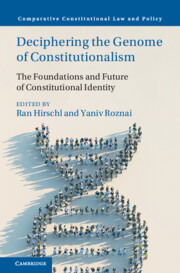Book contents
- Deciphering the Genome of Constitutionalism
- Comparative Constitutional Law and Policy
- Deciphering the Genome of Constitutionalism
- Copyright page
- Contents
- Figures
- Contributors
- Preface
- Acknowledgments
- Introduction
- Part I Foundations, Theory, and Concepts
- Part II Comparative Perspectives
- Part III American Constitutionalism and Constitutional Identity
- Part IV Emerging Trends
- 19 Constitution Making and Disharmonic Identity
- 20 Constitutional Identity and Unamendability
- 21 Illiberal Constitutionalism and the Abuse of Constitutional Identity
- 22 Deconstructing Constitutional Identity in Light of the Turn to Populism
- 23 Unconstitutional Constitutional Identities in The European Union
- 24 What Counts as Constitutional Identity?
- 25 Contrariness and Contradiction in Constitutional Law
- 26 Conclusion
- Index
- References
23 - Unconstitutional Constitutional Identities in The European Union
from Part IV - Emerging Trends
Published online by Cambridge University Press: 14 March 2024
- Deciphering the Genome of Constitutionalism
- Comparative Constitutional Law and Policy
- Deciphering the Genome of Constitutionalism
- Copyright page
- Contents
- Figures
- Contributors
- Preface
- Acknowledgments
- Introduction
- Part I Foundations, Theory, and Concepts
- Part II Comparative Perspectives
- Part III American Constitutionalism and Constitutional Identity
- Part IV Emerging Trends
- 19 Constitution Making and Disharmonic Identity
- 20 Constitutional Identity and Unamendability
- 21 Illiberal Constitutionalism and the Abuse of Constitutional Identity
- 22 Deconstructing Constitutional Identity in Light of the Turn to Populism
- 23 Unconstitutional Constitutional Identities in The European Union
- 24 What Counts as Constitutional Identity?
- 25 Contrariness and Contradiction in Constitutional Law
- 26 Conclusion
- Index
- References
Summary
The concept of “constitutional identity” in the context of the EU has evolved significantly over the years, leading to complex debates and challenges. This chapter explores the historical trajectory of constitutional identity in the EU, from its early emergence in response to concerns about sovereignty to its current state of political and legal contestation. The chapter highlights that while constitutional identity is a global concept, the European experience exhibits distinct characteristics. Two noteworthy factors contributing to this distinctiveness are Europe’s legal integration and the inclusion of an identity clause in EU law (Article 4(2) TEU), a unique feature in supranational constitutionalism. The chapter argues against abandoning the concept of constitutional identity due to its recent abuses, asserting that it is a legally recognized notion within EU law. Instead, the chapter claims the focus should be on identifying and addressing abuses while acknowledging the concept’s importance in balancing competing fundamental principles within the EU legal framework. It concludes by emphasizing the need to distinguish between legitimate uses of constitutional identity and its abusive applications, advocating for the protection of constitutional identities that align with EU core principles and calling for the development of a European constitutional identity as a complementary concept.
Keywords
- Type
- Chapter
- Information
- Deciphering the Genome of ConstitutionalismThe Foundations and Future of Constitutional Identity, pp. 300 - 311Publisher: Cambridge University PressPrint publication year: 2024



